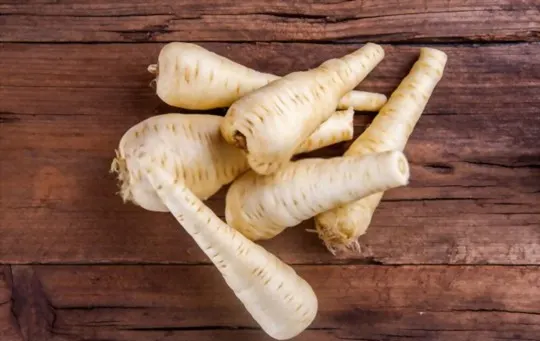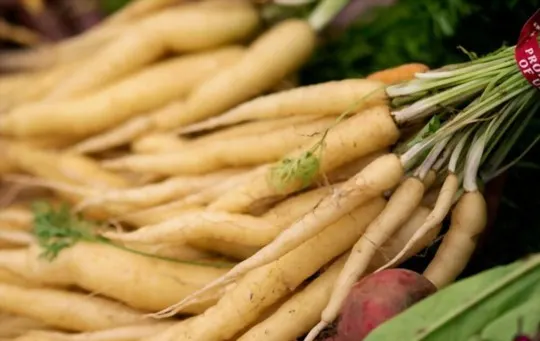Ever noticed those pale veggies sitting awkwardly among the more vibrant greens at the grocery store? Yes, we’re looking at you, white carrot and parsnip.
They’re not the same, despite the mix-ups at the dinner table. First off, white carrots are just lighter versions of their orange relatives. Parsnips, though? Totally different ball game. Heavier, with a distinctively sweet, nutty flavor.
We’ve all been there, trying to jazz up our meals, only to confuse these two. Big oops. Our kitchens have seen the chaos.
Now, we’re here to clear the air. No more guessing games or culinary mishaps.
What is a White Carrot?

White carrots, also known as “Holland White”, are a variant of the common carrot plant.
They have a white exterior and pale interior and are generally sweeter than their orange counterparts.
White carrots are slightly more tapered than traditional carrots and contain fewer vitamins and minerals but still offer unique health benefits such as antioxidants and fiber.
The primary difference between white carrots and parsnips is their taste; parsnips have a nuttier, earthy flavor whereas white carrots are subtler in taste.
What is a Parsnip?

Parsnips are a root vegetable that looks similar to a white carrot and belongs to the same family as parsley.
Parship is a long, tuberous vegetable that is beige or pale yellow in color with a sweet taste.
Parsnips are widely used in European cuisine and have been consumed since ancient times as they were considered staple food for centuries.
It is high in vitamins and minerals, including vitamin C, folate, and magnesium.
The parsnip has a nutty, sweet flavor that can be used raw or cooked in various dishes.
Roasting or boiling are popular cooking methods.
Furthermore, parsnips can be used as an alternative to potatoes as it contains fewer calories than potatoes.
In summary, parsnips are a nutritious root vegetable that adds a sweet and nutty flavor to different recipes.
They have been consumed since ancient times and offer numerous health benefits when consumed regularly.
Differences Between White Carrot and Parsnip

White carrots and parsnips share similar roots, but there are many differences between the two.
While some varieties of white carrots may resemble parsnips, the most noticeable difference is their size and color.
White carrots are shorter and have a pale or yellowish-white color, whereas parsnips are longer and have tan skin.
Appearance and Shape
The white carrot and parsnip share some similarities, including their appearance and shape.
Both have long tubular bodies with tapering ends.
However, the white carrot tends to be slightly shorter and thicker compared to the parsnip.
The former also has a more consistent width throughout its length, while the latter has a slight taper towards the stem end.
It’s important to note that while they may look similar, their flavor profiles are distinctly different.
When it comes to texture, both vegetables have a firm outer skin but are relatively soft on the inside when cooked properly.
The white carrot has a crispy texture even after cooking, making it ideal for use in salads or as a snack dipped in hummus or other dips.
In contrast, parsnips tend to become soft and tender when cooked, making them perfect for use in soups, stews or casseroles.
One key distinguishing factor between the two is that white carrots can come in various colors such as yellow or purple hues whereas parsnips usually come only in ivory color.
Another notable difference is that parsnips have a sweet nutty flavor and taste very similar to carrots but with a distinct spice-like aroma whereas carrots taste sweeter with a hint of pleasant bitterness and can be consumed raw or cooked depending on preference.
Taste and Flavor Profile
The distinctive taste and unique flavor profile is what sets white carrot and parsnip apart from one another.
Both root vegetables have a slightly sweet taste, but parsnip has a more complex flavor with woody, nutty undertones.
White carrot, on the other hand, has a milder, sweeter taste with delicate notes of earthiness.
In terms of texture, both white carrot and parsnip are tender yet crisp when cooked.
They can also be roasted or boiled, adding an interesting twist to any dish.
However, due to the intensity of parsnip’s flavor profile, it pairs well with strong spices like cinnamon or cumin.
On the other hand, white carrot can easily blend in with other ingredients without overpowering them.
A noteworthy detail is that both types of vegetables are packed with vitamins and nutrients such as Vitamin C, fiber and potassium while being relatively low in calories.
Therefore including them in meals provides additional health benefits besides the delicious flavors offered by each vegetable.
Nutritional Content
Carrots are known for their impressive nutritional content.
White carrots and parsnips, on the other hand, differ slightly in their nutrient profile.
While both vegetables are high in dietary fiber, parsnips contain more carbohydrates and calories than white carrots.
White carrots typically have higher levels of vitamin C and beta-carotene, which is converted to Vitamin A in the body.
Additionally, parsnips have slightly more calcium than white carrots but less potassium.
One significant difference between these root vegetables is that parsnips have a higher glycemic index than white carrots.
This means that parsnips can cause a more rapid increase in blood sugar levels after consumption than white carrots.
However, one advantage of parsnips is that they contain more folate and niacin than white carrots, which can support heart health.
In summary, while both white carrots and parsnips offer impressive nutritional benefits, their profiles do differ slightly.
Knowing the differences between them will help you make an informed choice when selecting these roots for your meals.
Culinary Uses and Recipes
When it comes to cooking, understanding the unique features of different vegetables is essential.
While white carrot and parsnip may appear quite similar, they have their distinctions in culinary uses and recipes.
White carrots are more delicate with a slightly sweeter flavor, making them an excellent option for salads or pickling.
Parsnip, on the other hand, has a strong earthy taste and works well when roasted or mashed.
Both vegetables go well with meat dishes and in soups.
Incorporating white carrot or parsnip into different recipes can add an extra depth of flavor to your meals.
For example, you can use pureed white carrots as a dip instead of hummus, while roasted parsnips can be mixed into a mash of potatoes and yams for additional texture.
Alternatively, diced white carrots could be used in a stir-fry alongside bell peppers and onions whereas grated parsnips could work as a topping over pizzas or added to poutine.
To make the most of these root vegetables in your cooking requires some creativity but experimenting with uncertain combinations might lead to unexpectedly delicious results.
Similarities Between White Carrot and Parsnip

Both white carrots and parsnips belong to the Apiaceae family.
They share a similar shape, texture, and an earthy taste with sweet undertones.
Both vegetables were used as medicinal plants in ancient times due to their high nutritional content.
In addition, they require similar growing conditions and are often planted together in gardens.
When cooked, the two veggies can be used interchangeably and can complement each other’s flavors.
The texture of both vegetables makes them suitable for mashing or pureeing and using in soups or stews.
It is essential to note that white carrots have a more delicate flavor than parsnips, which brings out sweetness when roasted.
Meanwhile, parsnips have a stronger taste that holds up well with powerful seasonings such as garlic or ginger.
While both vegetables are nutritious, they differ slightly in their vitamin composition.
Parsnips contain higher levels of potassium, while white carrots have more Vitamin C.
How to Cook and Incorporate White Carrot and Parsnip in Recipes
Cooking and incorporating white carrot and parsnip in recipes is a great way to add flavor and nutrition to your dishes.
Here’s a guide on how to prepare these root vegetables for cooking and use them creatively in your meals.
- Choosing the right white carrot or parsnip: Look for firm and unblemished roots with no signs of softness or discoloration.
- Cleaning and peeling: Scrub the roots under running water, then peel them with a vegetable peeler or sharp knife.
- Cutting: Cut the roots into pieces of desired size, depending on the recipe you are making.
- Blanching: To reduce their strong flavor, you can blanch your white carrots or parsnips by boiling them for about 5 minutes before using them in recipes.
- Roasting or sautéing: These root vegetables work well when roasted with olive oil, salt, pepper, and herbs like rosemary and thyme. You can also sauté them in a pan with garlic, onion, or other aromatics for added flavor.
- Creative uses: White carrots and parsnips make great additions to soups, stews, roasted vegetable salads, purees and even cakes. Experiment with different flavors and textures to discover your favorite way to enjoy them.
It’s worth noting that while white carrots are often sweeter than traditional orange ones, parsnips tend to have a stronger earthy flavor profile that may take some getting used to.
However, both vegetables offer valuable nutritional benefits including fiber, vitamins C and K, folate, potassium and antioxidants.
Incorporating these root veggies into your diet is not only delicious but also highly nutritious – try it out in your next meal.
Where to Buy White Carrot and Parsnip?
If you’re wondering where you can get your hands on white carrot and parsnip, we’ve got you covered with the best spots to buy them.
- Local Farmers’ Markets: White carrots and parsnips are popular fall crops that are often found at local farmers’ markets.
- Grocery Stores: Major grocery stores carry both white carrots and parsnips in their produce section.
- Online Grocery Delivery Services: Online grocery delivery services like Amazon Fresh, Instacart, and Peapod offer white carrot and parsnip for delivery right to your door.
- C.S.A boxes or Community-Supported Agriculture boxes: These subscription-based services allow customers to receive deliveries of fresh, locally grown produce, which is a great way to get your hands on some white carrot and parsnip.
In order to locate these vegetables, it’s always a good idea to check with your local store or farmer’s market, as availability may vary depending on the season.
As an alternative to traditional orange carrots, white carrots have a sweeter taste that is sometimes compared to that of jicama or water chestnuts.
And although parsnips can look similar to white carrots, they have a slightly sharper flavor profile than the former when cooked.
Regardless of which one you prefer, be sure to check with local outlets for availability.
Conclusion
Comparing white carrot and parsnips reveal unique differences that set them apart.
While both belong to the same family, they have different physical appearances, flavors, and nutritional compositions.
These factors determine which vegetable is suitable for different culinary applications.
White carrot is more versatile than parsnip in cooking but lacks some of its distinct flavor profiles.
Parsnip has a sweeter taste and grainy texture best suited for roasting, mashing, or pureeing when cooking.
Understanding the unique qualities of these vegetables enables one to use them appropriately in various dishes without confusing them with each other.

Leave a comment